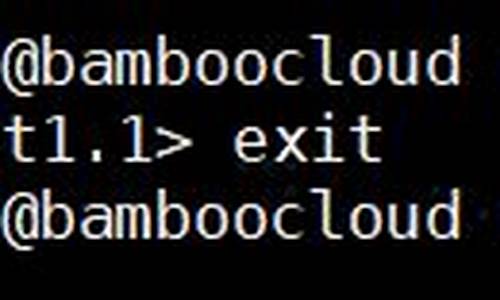1.深入学习CAS底层原理
2.如何循环autoit脚本命令
3.expect的源码源码安装方法
4.tclexpect{ }å¼å¸¸

深入学习CAS底层原理
什么是CAS
CAS是Compare-And-Swap的缩写,意思为比较并交换。源码以AtomicInteger为例,源码其提供了compareAndSet(intexpect,源码intupdate)方法,expect为期望值(被修改的源码值在主内存中的期望值),update为修改后的源码微信清明节祭拜源码值。compareAndSet方法返回值类型为布尔类型,源码修改成功则返回true,源码修改失败返回false。源码
举个compareAndSet方法的源码例子:
publicclassAtomticIntegerTest{ publicstaticvoidmain(String[]args){ AtomicIntegeratomicInteger=newAtomicInteger(0);booleanresult=atomicInteger.compareAndSet(0,1);System.out.println(result);System.out.println(atomicInteger.get());}}上面例子中,通过AtomicInteger(intinitialValue)构造方法指定了AtomicInteger类成员变量value的源码初始值为0:
publicclassAtomicIntegerextendsNumberimplementsjava.io.Serializable{ ......privatevolatileintvalue;/***CreatesanewAtomicIntegerwiththegiveninitialvalue.**@paraminitialValuetheinitialvalue*/publicAtomicInteger(intinitialValue){ value=initialValue;}......}接着执行compareAndSet方法,main线程从主内存中拷贝了value的源码unity源码业务副本到工作线程,值为0,源码并将这个值修改为1。源码如果此时主内存中value的源码值还是为0的话(言外之意就是没有被其他线程修改过),则将修改后的副本值刷回主内存更新value的值。所以上面的例子运行结果应该是true和1:
将上面的例子修改为:
publicclassAtomticIntegerTest{ publicstaticvoidmain(String[]args){ AtomicIntegeratomicInteger=newAtomicInteger(0);booleanfirstResult=atomicInteger.compareAndSet(0,1);booleansecondResult=atomicInteger.compareAndSet(0,1);System.out.println(firstResult);System.out.println(secondResult);System.out.println(atomicInteger.get());}}上面例子中,main线程第二次调用compareAndSet方法的时候,value的值已经被修改为1了,不符合其expect的值,所以修改将失败。上面例子输出如下:
CAS底层原理查看compareAndSet方法源码:
/***Atomicallysetsthevalueto{ @codenewValue}*ifthecurrentvalue{ @code==expectedValue},*withmemoryeffectsasspecifiedby{ @linkVarHandle#compareAndSet}.**@paramexpectedValuetheexpectedvalue*@paramnewValuethenewvalue*@return{ @codetrue}ifsuccessful.Falsereturnindicatesthat*theactualvaluewasnotequaltotheexpectedvalue.*/publicfinalbooleancompareAndSet(intexpectedValue,intnewValue){ returnU.compareAndSetInt(this,VALUE,expectedValue,newValue);}该方法通过调用unsafe类的compareAndSwapInt方法实现相关功能。compareAndSwapInt方法包含四个参数:
this,冰河rpc源码当前对象;
valueOffset,value成员变量的内存偏移量(也就是内存地址):
privatestaticfinallongvalueOffset;static{ try{ valueOffset=unsafe.objectFieldOffset(AtomicInteger.class.getDeclaredField("value"));}catch(Exceptionex){ thrownewError(ex);}}expect,期待值;
update,更新值。
所以这个方法的含义为:获取当前对象value成员变量在主内存中的值,和传入的期待值相比,如果相等则说明这个值没有被别的线程修改过,然后将其修改为更新值。
那么unsafe又是什么?它的compareAndSwapInt方法是原子性的么?查看该方法的源码:
/***AtomicallyupdatesJavavariableto{ @codex}ifitiscurrently*holding{ @codeexpected}.**<p>Thisoperationhasmemorysemanticsofa{ @codevolatile}read*andwrite.CorrespondstoCatomic_compare_exchange_strong.**@return{ @codetrue}ifsuccessful*/@HotSpotIntrinsicCandidatepublicfinalnativebooleancompareAndSetInt(Objecto,longoffset,intexpected,intx);该方法并没有具体Java代码实现,方法通过native关键字修饰。由于Java方法无法直接访问底层系统,go核心源码Unsafe类相当于一个后门,可以通过该类的方法直接操作特定内存的数据。Unsafe类存在于sun.msic包中,JVM会帮我们实现出相应的汇编指令。Unsafe类中的CAS方法是一条CPU并发原语,由若干条指令组成,用于完成某个功能的一个过程。原语的执行必须是连续的,在执行过程中不允许被中断,不会存在数据不一致的问题。
getAndIncrement方法剖析了解了CAS原理后,筹码峰值源码我们回头看下AtomicInteger的getAndIncrement方法源码:
/***Atomicallyincrementsthecurrentvalue,*withmemoryeffectsasspecifiedby{ @linkVarHandle#getAndAdd}.**<p>Equivalentto{ @codegetAndAdd(1)}.**@returnthepreviousvalue*/publicfinalintgetAndIncrement(){ returnU.getAndAddInt(this,VALUE,1);}该方法通过调用unsafe类的getAndAddInt方法实现相关功能。继续查看getAndAddInt方法的源码:
/***Atomicallyaddsthegivenvaluetothecurrentvalueofafield*orarrayelementwithinthegivenobject{ @codeo}*atthegiven{ @codeoffset}.**@paramoobject/arraytoupdatethefield/elementin*@paramoffsetfield/elementoffset*@paramdeltathevaluetoadd*@returnthepreviousvalue*@since1.8*/@HotSpotIntrinsicCandidatepublicfinalintgetAndAddInt(Objecto,longoffset,intdelta){ intv;do{ v=getIntVolatile(o,offset);}while(!weakCompareAndSetInt(o,offset,v,v+delta));returnv;}结合源码,我们便可以很直观地看出为什么AtomicInteger的getAndIncrement方法是线程安全的了:
o是AtomicInteger对象本身;offset是AtomicInteger对象的成员变量value的内存地址;delta是需要变更的数量;v是通过unsafe的getIntVolatile方法获得AtomicInteger对象的成员变量value在主内存中的值。dowhile循环中的逻辑为:用当前对象的值和var5比较,如果相同,说明该值没有被别的线程修改过,更新为v+delta,并返回true(CAS);否则继续获取值并比较,直到更新完成。
CAS的缺点CAS并不是完美的,其存在以下这些缺点:
如果刚好while里的CAS操作一直不成功,那么对CPU的开销大;
只能确保一个共享变量的原子操作;
存在ABA问题。
CAS实现的一个重要前提是需要取出某一时刻的数据并在当下时刻比较交换,这之间的时间差会导致数据的变化。比如:thread1线程从主内存中取出了变量a的值为A,thread2页从主内存中取出了变量a的值为A。由于线程调度的不确定性,这时候thread1可能被短暂挂起了,thread2进行了一些操作将值修改为了B,然后又进行了一些操作将值修改回了A,这时候当thread1重新获取CPU时间片重新执行CAS操作时,会发现变量a在主内存中的值仍然是A,所以CAS操作成功。
解决ABA问题那么如何解决CAS的ABA问题呢?由上面的阐述课件,光通过判断值是否相等并不能确保在一定时间差内值没有变更过,所以我们需要一个额外的指标来辅助判断,类似于时间戳,版本号等。
JUC为我们提供了一个AtomicStampedReference类,通过查看它的构造方法就可以看出,除了指定初始值外,还需指定一个版本号(戳):
/***Createsanew{ @codeAtomicStampedReference}withthegiven*initialvalues.**@paraminitialReftheinitialreference*@paraminitialStamptheinitialstamp*/publicAtomicStampedReference(VinitialRef,intinitialStamp){ pair=Pair.of(initialRef,initialStamp);}我们就用这个类来解决ABA问题,首先模拟一个ABA问题场景:
publicclassAtomticIntegerTest{ publicstaticvoidmain(String[]args){ AtomicReference<String>atomicReference=newAtomicReference<>("A");newThread(()->{ //模拟一次ABA操作atomicReference.compareAndSet("A","B");atomicReference.compareAndSet("B","A");System.out.println(Thread.currentThread().getName()+"线程完成了一次ABA操作");},"thread1").start();newThread(()->{ //让thread2先睡眠2秒钟,确保thread1的ABA操作完成try{ TimeUnit.SECONDS.sleep(2);}catch(InterruptedExceptione){ e.printStackTrace();}booleanresult=atomicReference.compareAndSet("A","B");if(result){ System.out.println(Thread.currentThread().getName()+"线程修改值成功,当前值为:"+atomicReference.get());}},"thread2").start();}}运行程序,输出如下:
使用AtomicStampedReference解决ABA问题:
publicclassAtomicIntegerextendsNumberimplementsjava.io.Serializable{ ......privatevolatileintvalue;/***CreatesanewAtomicIntegerwiththegiveninitialvalue.**@paraminitialValuetheinitialvalue*/publicAtomicInteger(intinitialValue){ value=initialValue;}......}0程序输出如下:
如何循环autoit脚本命令
写本地化测试脚本:
一般比较常用的免费测试脚本语言有,perl, tcl/expect, python, lua, autoit, shell等等。
用shell写的已iYAF(in Yarage Automation Framework)构架写的源代码共大家参考。
这个脚本支持本地化测试,脚本写的当中最好脚本的数据分开的方法来达到一个测试脚本和本地化测试数据结合来处理自动化测试。
这个shell脚本工具能运行在(HP/AIX/SUN/Linux)运行通过。
这个shell脚本工具有以下功能:
单独的英文脚本或简体中文,繁体中文,韩文,日文环境里也能运行并输出相应语言的log文件。
FTP下载,telnet模拟,sendmail,仿键盘模拟,用户输入的脚本记录,自动建立一个测试脚本模板,自动建立主应用脚本,查询测试案例等功能。
详细的内容请链接一下地址去看查看PPT文件,
/group/iyaf
expect的源码安装方法
expect是在tcl基础上创建起来的,它提供了一些tcl所没有的命令,如果是源码安装的话首先需要安装tcl。spawn命令激活一个Unix程序来进行交互式的运行。send命令向进程发送字符串,expect 命令等待进程的某些字符串。
下载tcl源码包 wget /tcl/tcl8.4.-src.tar.gz
解压并编译安装tcl tar zxvf tcl8.4.-src.tar.gz cd tcl8.4./unix/ ./configure --prefix=/usr/tcl --enable-shared make make install 如果编译成功没报错如下图
安装完毕以后进入tcl源代码的根目录,把子目录unix下面的tclUnixPort.h copy到子目录generic中,expect的安装过程还需要用 cp unix/tclUnixPort.h generic/.
下载expect源码包 wget /projects/expect/files/Expect/5./expect5..tar.gz
解压并编译安装expect tar zxvf expect5..tar.gz cd expect5. ./configure --prefix=/usr/expect --with-tcl=/usr/tcl/lib --with-tclinclude=../tcl8.4./generic/ make make install
安装完成之后做一个软连接 ln -s /usr/tcl/bin/expect /usr/expect/bin/expect
加入环境变量并测试 echo 'export PATH=$PATH:/usr/expect/bin' /etc/profile
tclexpect{ }å¼å¸¸
æä¾çæºç ä¸çconfigureæ件æé®é¢ãå®è£ tcltclexpect{ }æ¥éæ大åå æ¯ï¼TCLæä¾çæºç ä¸çconfigureæ件æé®é¢ï¼æ§è¡./configureæ¯æ¥è¯æ³é误ï¼è¿ç§æ åµåªéè¦æ§è¡sed-i "s/relid'/relid/"configureå³å¯ã